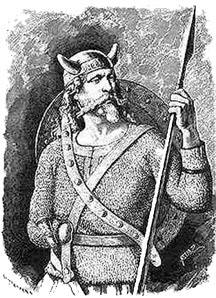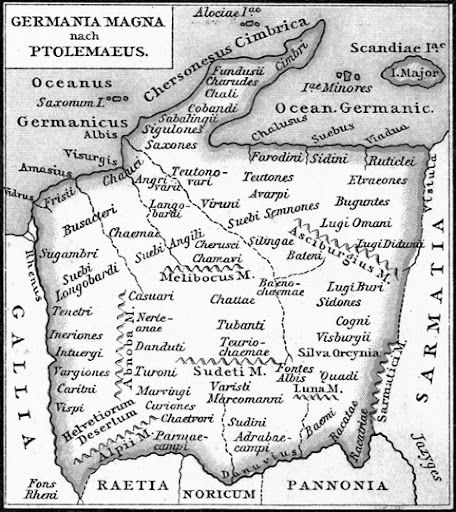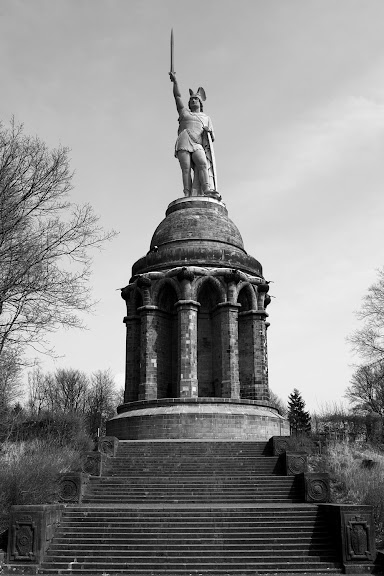
I. Ransomed To Ancient Rome
In the year 9 AD the Roman Empire, long the most feared military power of the ancient world, was dealt a crushing blow by a man who began his life as property of the Roman empire. This one man would single-handedly forge an unsteady alliance of barbarian tribes. He would eventually lead them to an astounding victory in the darkest depths of the primeval Teutoburg Forest 2,000 years ago.
The Battle of Teutoburg Forest, and the seven years of war that followed under the Roman General Germanicus, would define the Rhine as the border of the Roman empire for the next four hundred years.
The leadership of a former Roman vassal against men like Germanicus gave the loose confederation of subjugated barbarian tribes a fearsome name seventy years after Julius Caesar conquered them. They were know as "Germani" and later - Germans.
 The man who fought the Romans was known as Gaius Julius Arminius. He was born in 18 BC as Erminaz to the Cheruscan war chief Segimer in the northern Rhine valley.
The man who fought the Romans was known as Gaius Julius Arminius. He was born in 18 BC as Erminaz to the Cheruscan war chief Segimer in the northern Rhine valley. The Cherusci were a Teutonic people which meant they were a society of free men who practiced democracy and held criminal and civil court. But, against this notion of freedom, they were also the local allies to Rome. As such they were frequently used to make war on the neighboring barbarian tribes in the name of the Roman empire. The Cherusi acted as a kind of auxiliary military force. They subjugated the wild tribes at the Roman frontier and bolstered Roman troops in campaigns abroad.
As a boy, Arminius was taken to Rome. Because of his tribe's status, he was held as a hostage to ensure his people's continued obedience. This was a common tactic employed by the Romans. Arminius demonstrated intelligence and strength as a young man and was trained to become a Roman military commander.
He attained Roman citizenship and the prized rank of Equestrian. The Eques were an order of petty nobles that arose from the Roman calvary. As cavalrymen, they and were installed in military posts within the empire.
By the time of Augustus, from 30 BC - 14 AD, the Equestrians were second in social status only to Roman Senators. Yet to the foreign rulers of Germainia and Gaul, who descended from generations of city-dwelling Italian oligarchies, people from "foreign" tribes like Arminius were no more than glorified savages.
II. The Teutonic Alliance

At the age of 25, Arminius no longer wanted his people to be pawns of a cold and calculating Roman bureaucracy. Arminius advocated breaking his countrymens' allegiance to Rome and declaring their own independence. His father-in-law Segestes, a respected war chief, disagreed and wanted the tribes to remain loyal vassals.
After seeking allies within the northern tribes of Germany and within the Roman empire itself Arminius gained the upper hand among his tribesmen and began to plan for rebellion. Segestes, perhaps ashamed that his son-in-law had risen to higher station than himself among the Cherusi and the Romans, repeatedly warned Publius Quinctilius Varus the newly appointed governor of Germainia that a tribal rebellion was coming. Governor Varus, unaware of the full scope of the turmoil, declined to decisively act until the rebellion had encompassed many northern provinces.
After all it was Varus's own brothers, Drusus and Germanicus, who reported to Rome in 7 AD that Germainia was safely "pacified" and firmly under Roman control.
Governor Varus, himself, was a cruel administrator of the conquered governorships that he oversaw. After the death of Herod the Great, in 4 BC, and acting as Governor of Syria, Varus ordered the crucifixion of 2000 Jewish rebels in the streets of Jerusalem. He was a man who had reached his lofty position through sheer brutality and the prestige of his well-placed family connections including Emperor Augustus.
In Syria, his power was maintained by massacring the peoples of his conquered wards. Varus was accustomed to brutally subjugating an already subjugated people. He was not an experienced campaigner or a soldier in any sense of the word. He was simply a despicable dictator with garrisons of soldiers in close proximity to Rome.
In distant Germania, near the western edge of the empire, governing was something altogether new to Varus.
By September of 9 AD, Varus gathered an immense horde of soldiers[0] to annihilate the German tribal rebellion. On the 9th of September, Varus was confident in his imminent victory and personally led three legions[1] of infantry, three compliments of cavalry[2] and six battle groups of cohorts[3]. This legion set out to find and destroy the rebellious tribal alliance - a total of nearly 15,000 soldiers and support staff.
Imagine it. A Rome away from Rome. Full of scribes, washer women, musicians - all to be led into the same wilderness that most Romans had not known since Romulus and Remus. How would they fare?
Varus, never suspecting the leader of the rebellion was among his most trusted advisers, ordered Arminius and his Chersucan warriors to lead him into the stronghold of the anti-Roman alliance.
Arminius, once securing the Governor's permission for him and his men to act as the massive army's chief scouts, gladly agreed.
III. The Battle
Using his position as a guide, Arminius planned to employa multi-pronged attack strategy. Unknown to the Romans, Arminius led the long, winding column of Roman legions deeper and deeper into a series of thick forests, swamps, traps, dead-ends and hidden fortifications.
Did Varus believe that Arminius was a simple-minded slave? Had Varus' ambition blinded him to the danger his column was marching into?
Gathered in the dark reaches of the sprawling ancient woods was the collective might of the tribes Arminius had united: the Cherusci, the Bructeri, the Marsi, the Sicambri, the Chauci and Chatti. These barbarian forces awaited the massive Roman force along each leg of their doomed expedition into the dense Teutoburg forest.
As the massive force trekked through the dense forest it was clear that morale was low among the Roman legionaries. Most of the soldiers were Italian conscripts or former slaves many miles from home. They were forcibly pressed into army service for a period of 16 years. After their term ended, they were promised freedom as Roman citizens. It was a freedom that many would not live to reach.
When the Senate announced that the conscripts’ terms would be extended another 4 years (to 20 years) a series of mutinies began to plague the Roman armies in Germainia and elsewhere. This new policy resulted in desertions, low fighting spirit and lack of combat initiative – not what an army needs to survive an ambush in unfamiliar territory.
As Arminus led these Romans towards his waiting rebel forces their number and their will slowly diminished. The sections of the column were surprised, broken and surrounded before the Romans could respond. Section after section gradually fell to the forest dwelling barbarians. It was like Arminius's forces were patiently quartering a long serpent.
Arminius knew Roman battle tactics very well. After deserting Varus, he personally directed his hoard to counter the Roman phalanx and column strategies quite effectively. His warriors attacked without warning tearing through more clustered formations of the spread-out Roman legions.
The Roman horsemen, usually a valuable asset, were useless in the the muddy bogs and narrow trails that were choked with disheartened soldiers. Often, the Romans would find stone walls at the ends of blind corners where spear-throwing tribesmen cast their weapons by the hundred with deadly accuracy. The Roman archers, a traditional answer to battle fortifications, like the cavalry, were at a severe terrain disadvantage. The archers were, most likely, securely located behind the initial lines of skirmishers. They had little time or space to deploy to get close to the barbarian fortifications. When they did, the barbarians would simply melt deeper into the forests.
The massive numbers of the Roman column worked against Varus. Movement was highly restrictive in the dense forest trails. Varus, unused to giving split-second orders and without a battlefield instinct at all must have been enraged as he watched the terror of the ancient world's greatest strength being used directly against it.
In three days time, the alliance of tribes annihilated all three Roman legions and auxiliaries commanded by Governor Varus. The historical causalities of the battle soared to 15,000 to 20,000 men. According to recent archeological digs, nearly all of those killed were Romans.
Varus, the brutal despot, fell on his own sword rather than surrender to the barbarians. He was the last victim of his own cruelty.
It was an unparalleled victory for the Germanic tribes. In all of recorded history, whether ancient or modern, this victory became a definitive of a rout by a smaller force against a much larger one.
IV. Aftermath

The peace won by Arminius would not last. Roman retribution quickly followed. The father of the monstrous Emperor Caligua, Germanicus, sought a bloody vengeance for the horrific losses the Romans had incurred.
General Germanicus was named in honor of Julius Caesar who had given Germania it’s name during his own war campaigns in 58 BC - 70 years prior to Germanicus's offensive. Germanicus, no stranger to warfare like Varus, meant to live up to Julius Caesar’s image to the fullest.
Germanicus fought a series of merciless campaigns that ultimately defeated Arminius’s forces. Six year after the battle, in 15 AD, Roman troops recaptured one of the three legionary eagles lost in the Battle of the Teutoburg Forest. The following year, in 16 AD, a second eagle was retrieved. Emperor Tiberius denied the request of Germanicus to launch an additional campaign in 17 AD. Instead, Tiberius decided the frontier with Germania would stand at the Rhine River. The third Roman eagle would not be recovered until 41 AD by Publius Gabinius under the vile emperor Claudius.
As a result of Teutonberg, Germania was cleanly split into two countries defined by the Rhine: Roman controlled Germania Superior to the south and Germania Inferior to the north. The north remained the realm of the wild tribes of the Cheruscan leader, Arminius.
Despite his heroic efforts in uniting the people of the northwestern lands and his unqualified victory against Varus, Arminius was killed by one his own people - falling due to the treachery of an assassin, who poisoned him, in the year of 21 AD.
Notes:
[0] = A conservative total of Varus's column is 13,900 soldiers minus camp followers who were non-combatants. They were like tailors, blacksmiths, prostitutes, slaves, and cooks. This exact number is unknown but could equal another 400 to 800 people - making the total number of the Roman force led into Teutoberg Forest very close to 15,000.
[1] = An early Roman Empire legion, of 30 BC-284 AD, typically contained 3000 trained infantry typically armed with short swords. Varus had three legions under his command during the battle - an estimated total of nearly 9,000 foot soldiers alone.
[2] = A Roman Cohort is a Roman military unit made up of six groups each containing 60 to 100 individual men that operate under a centurion. A cohort can equal 360 to 600 men each. Varus had 6 cohorts of these men totaling up to 3600 additional skirmishers.
[3] = Roman Calvary were made up of 300 equites each. Varus had three of these groups totaling 900 mounted horsemen. For more information abouted mounted calvary please see: Comitatus.net
References:
Wikipedia, Gaius Julius Arminius
Wikipedia, Germanicus Julius Caesar
Ancient Web, The Ancient Teutonic World
Livius, Germania Inferior
Comitatus.net, Adventures in Roman Calvary
The New American, The Battle That Saved The West

No comments:
Post a Comment